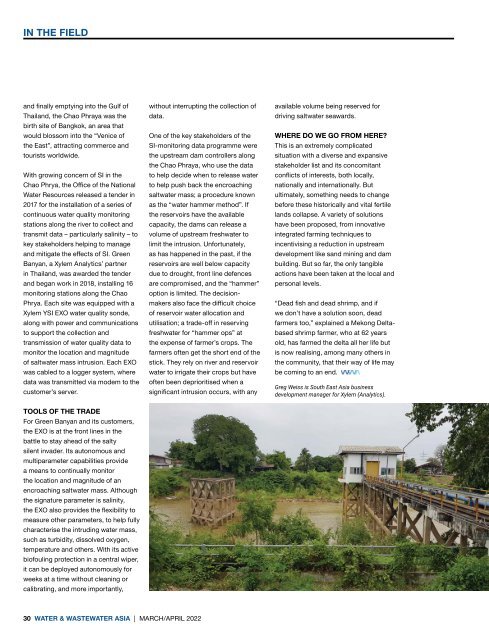Water & Wastewater Asia March/April 2022
Water & Wastewater Asia is an expert source of industry information, cementing its position as an indispensable tool for trade professionals in the water and wastewater industry. As the most reliable publication in the region, industry experts turn this premium journal for credible journalism and exclusive insight provided by fellow industry professionals. Water & Wastewater Asia incorporates the official newsletter of the Singapore Water Association (SWA).
Water & Wastewater Asia is an expert source of industry information, cementing its position as an indispensable tool for trade professionals in the water and wastewater industry. As the most reliable publication in the region, industry experts turn this premium journal for credible journalism and exclusive insight provided by fellow industry professionals. Water & Wastewater Asia incorporates the official newsletter of the Singapore Water Association (SWA).
You also want an ePaper? Increase the reach of your titles
YUMPU automatically turns print PDFs into web optimized ePapers that Google loves.
IN THE FIELD<br />
and finally emptying into the Gulf of<br />
Thailand, the Chao Phraya was the<br />
birth site of Bangkok, an area that<br />
would blossom into the “Venice of<br />
the East”, attracting commerce and<br />
tourists worldwide.<br />
With growing concern of SI in the<br />
Chao Phrya, the Office of the National<br />
<strong>Water</strong> Resources released a tender in<br />
2017 for the installation of a series of<br />
continuous water quality monitoring<br />
stations along the river to collect and<br />
transmit data – particularly salinity – to<br />
key stakeholders helping to manage<br />
and mitigate the effects of SI. Green<br />
Banyan, a Xylem Analytics’ partner<br />
in Thailand, was awarded the tender<br />
and began work in 2018, installing 16<br />
monitoring stations along the Chao<br />
Phrya. Each site was equipped with a<br />
Xylem YSI EXO water quality sonde,<br />
along with power and communications<br />
to support the collection and<br />
transmission of water quality data to<br />
monitor the location and magnitude<br />
of saltwater mass intrusion. Each EXO<br />
was cabled to a logger system, where<br />
data was transmitted via modem to the<br />
customer’s server.<br />
without interrupting the collection of<br />
data.<br />
One of the key stakeholders of the<br />
SI-monitoring data programme were<br />
the upstream dam controllers along<br />
the Chao Phraya, who use the data<br />
to help decide when to release water<br />
to help push back the encroaching<br />
saltwater mass; a procedure known<br />
as the “water hammer method”. If<br />
the reservoirs have the available<br />
capacity, the dams can release a<br />
volume of upstream freshwater to<br />
limit the intrusion. Unfortunately,<br />
as has happened in the past, if the<br />
reservoirs are well below capacity<br />
due to drought, front line defences<br />
are compromised, and the “hammer”<br />
option is limited. The decisionmakers<br />
also face the difficult choice<br />
of reservoir water allocation and<br />
utilisation; a trade-off in reserving<br />
freshwater for “hammer ops” at<br />
the expense of farmer’s crops. The<br />
farmers often get the short end of the<br />
stick. They rely on river and reservoir<br />
water to irrigate their crops but have<br />
often been deprioritised when a<br />
significant intrusion occurs, with any<br />
available volume being reserved for<br />
driving saltwater seawards.<br />
WHERE DO WE GO FROM HERE?<br />
This is an extremely complicated<br />
situation with a diverse and expansive<br />
stakeholder list and its concomitant<br />
conflicts of interests, both locally,<br />
nationally and internationally. But<br />
ultimately, something needs to change<br />
before these historically and vital fertile<br />
lands collapse. A variety of solutions<br />
have been proposed, from innovative<br />
integrated farming techniques to<br />
incentivising a reduction in upstream<br />
development like sand mining and dam<br />
building. But so far, the only tangible<br />
actions have been taken at the local and<br />
personal levels.<br />
“Dead fish and dead shrimp, and if<br />
we don’t have a solution soon, dead<br />
farmers too,” explained a Mekong Deltabased<br />
shrimp farmer, who at 62 years<br />
old, has farmed the delta all her life but<br />
is now realising, among many others in<br />
the community, that their way of life may<br />
be coming to an end.<br />
Greg Weiss is South East <strong>Asia</strong> business<br />
development manager for Xylem (Analytics).<br />
TOOLS OF THE TRADE<br />
For Green Banyan and its customers,<br />
the EXO is at the front lines in the<br />
battle to stay ahead of the salty<br />
silent invader. Its autonomous and<br />
multiparameter capabilities provide<br />
a means to continually monitor<br />
the location and magnitude of an<br />
encroaching saltwater mass. Although<br />
the signature parameter is salinity,<br />
the EXO also provides the flexibility to<br />
measure other parameters, to help fully<br />
characterise the intruding water mass,<br />
such as turbidity, dissolved oxygen,<br />
temperature and others. With its active<br />
biofouling protection in a central wiper,<br />
it can be deployed autonomously for<br />
weeks at a time without cleaning or<br />
calibrating, and more importantly,<br />
30 WATER & WASTEWATER ASIA | MARCH/APRIL <strong>2022</strong>


















